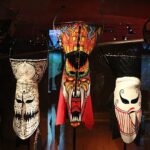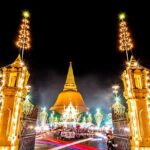
In Chiang Rai’s lush landscapes, Huai Pla Kang Temple reflects harmonious Thai and Chinese cultural coexistence. Also known as Wat Huay Pla Kang, this sacred site captures traditional Buddhist practices and showcases a unique fusion of architectural styles, attracting spiritual seekers and cultural enthusiasts.
A Tapestry of Architecture
Huai Pla Kang Temple greets visitors with an impressive entrance adorned with intricate dragon motifs, nodding to Chinese design. The temple’s main pagoda, or chedi, rises majestically, drawing inspiration from both Thai and Chinese architectural styles. Vibrant colors and intricate detailing adorn its tiers, creating a mesmerizing visual spectacle against the backdrop of the northern Thai hills.
The main attraction is a giant Guan Yin statue, standing at an impressive 25 meters tall—one of Thailand’s largest. The statue, constructed in the style of Chinese Buddhist art, radiates tranquility and compassion. Climb the spiraling staircase inside the statue for panoramic views and a unique perspective on Buddhist iconography.
Spiritual Serenity and Cultural Harmony
Beyond its architectural marvels, Huai Pla Kang Temple is a place of spiritual serenity and cultural harmony. Moreover, the expansive grounds allow contemplation. The complex invites participation in rituals, prayers, and experiencing the peaceful atmosphere surrounding the temple.
The temple’s courtyards feature smaller shrines, beautifully landscaped gardens, and reflective ponds, creating a serene environment for spiritual reflection. Throughout the day, the melodious sounds of Buddhist chants echo through the air, adding to the overall sense of tranquility.
A Center for Cultural Exploration
The temple serves as a cultural center, exploring shared Thai-Chinese history. Additionally, its museum showcases artifacts, deepening understanding of intertwined cultures.
Visitors can also partake in various cultural activities, from traditional Thai and Chinese ceremonies to art exhibitions and performances. These experiences allow guests to connect with the rich tapestry of traditions that have shaped the temple’s identity.

Pilgrimage and Festivities
Huai Pla Kang Temple is not only a place of spiritual significance but also a hub for religious pilgrimages and vibrant celebrations. Pilgrims from different parts of Thailand and beyond visit the temple to pay homage to the Guan Yin statue and seek blessings. During special festivals, the temple comes alive with colorful processions, cultural performances, and offerings, providing a unique opportunity for visitors to immerse themselves in the local traditions.
Plan Your Visit
For those seeking a spiritual retreat or a cultural adventure, Huai Pla Kang Temple in Chiang Rai beckons with open arms. Plan your visit to explore the blend of Thai and Chinese influences, witness the architectural splendor, and bask in the serene ambiance that defines this unique destination in northern Thailand. Whether you are a seasoned traveler or a spiritual seeker, Huai Pla Kang Temple offers an enriching experience that goes beyond the ordinary.
Additionally, let’s continue to Doi Tung Palace , which is in the same area of the province.
More pictures here










